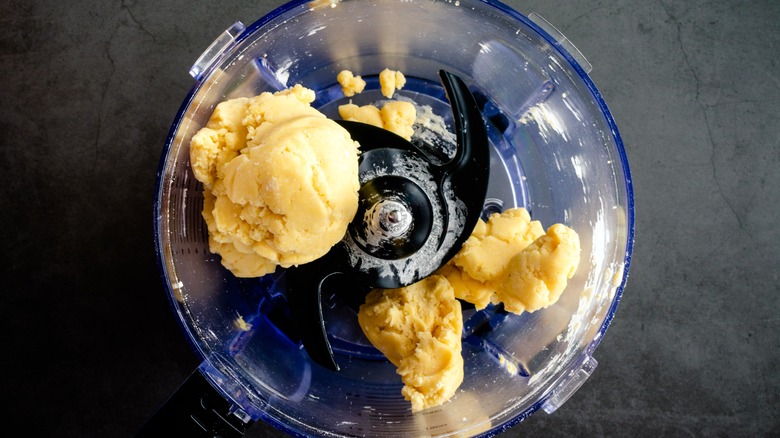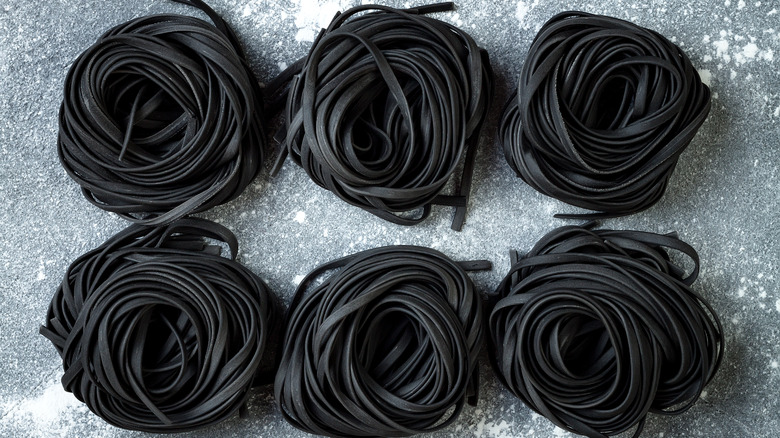Bobby Flay's Pro Tip For Making Fresh Pasta In No Time
One of the more challenging things about making fresh pasta is that cooks need to rely on experience rather in addition to a recipe to make it right. Factors like humidity, egg size, and the type of flour used can alter measurements, requiring cooks to think on their toes and adapt. Skilled pasta makers don't need a recipe; they can feel the dough needs more flour or water and react. This can be intimidating for home cooks new to pasta making, but it shouldn't deter you from learning how to make fresh pasta.
After spending time on the Amalfi Coast, Bobby Flay shared tips for creating fresh pasta. Flay's modern approach uses a food processor to do most of the work, resulting in fresh pasta in no time. Instead of mounding flour, eggs, and water on the countertop to form a well, the ingredients are added to a food processor. Depending on the recipe and how many servings you prepare, this can take just a few minutes and is less messy than the traditional method.
Flay's food processor method is the same for any pasta dough recipe. However, the chef likes to include squid ink to flavor and color the dough. A tablespoon of squid ink turns the dough deep black, imparting umami to this striking-looking pasta. The ingredients are pulsed using the standard blade attachment until a dry dough ball is formed. After roughly a minute of hand kneading, the dough is ready to rest before rolling and cutting.
Tips for making fresh pasta in a food processor
Since measurements alter each time it's made, it's helpful to know a few sensory clues that indicate when the pasta dough is ready to knead, which comes with experience. While Bobby Flay's method for making fresh pasta enables you to prepare Roman-style spaghetti alla carbonara any day of the week (including Wednesday), you should be mindful of a few things to ensure the dough isn't underprocessed.
Unlike cookies and cakes, which get tough from overmixing, pasta dough requires some kneading (but not too much) to achieve the perfect mouthfeel — an elasticity that isn't too firm and is a bit chewy. To achieve the ideal consistency, the flour's gluten proteins must be activated by a liquid and worked until stretched. It's a mistake to assume that the pasta is ready as soon as the dough comes together. Allow the processor to do the work until it looks and sounds like it's struggling; then, it's time to roll up your sleeves and get your hands dirty.
Pasta dough is forgiving. Mistakes are easily fixed; add a little flour if the dough is wet and more liquid if it's too crumbly. To prevent ping-ponging back and forth (adding more water than more flour), add small amounts of water at a time and allow the machine to run a bit before determining if you need more. A teaspoon of water can differentiate between soft and supple dough and a sticky blob.
How you know when fresh pasta dough is kneaded enough
In the beginning, before you've added all the liquid, the food processor will emit a steady hum since the machine doesn't have to work as hard. As the dough forms a ball, the appliance will sound like it's stuttering or like your car has a flat tire. The machine may start rocking from the uneven weight distribution. When the dough appears to be hula hooping around the blade in one mass, it's time to knead it by hand.
Work the dough on a lightly floured surface until it's smooth and elastic, adding more flour if it's sticky. If the dough feels dry, try wetting a hand and then continue kneading to see if there is enough moisture. When it's ready, the dough should be springy, and its texture should be similar to a rare steak, using the finger test. It should feel like the fleshy part between your thumb and forefinger when poked: bouncy. Wrap the dough in plastic and allow it to rest for at least 30 minutes.
It's essential to work the dough in small batches as you roll and cut it into shapes to prevent it from drying out. Bobby Flay prefers to cut his rolled squid ink pasta into fettuccini, which he coils into a loose nest on a floured sheet pan. Alternatively, you can hang the strands to dry the pasta if you aren't using it immediately or prepare your favorite shape.



